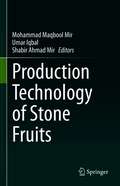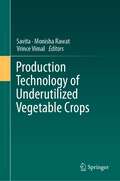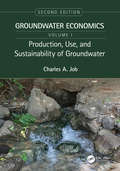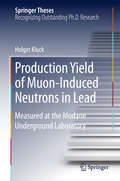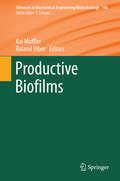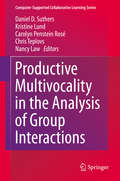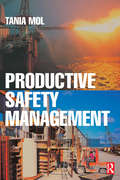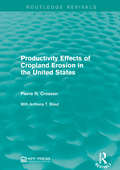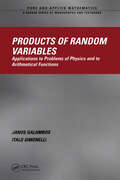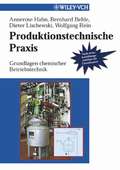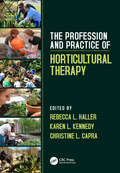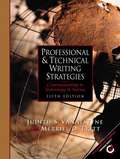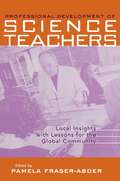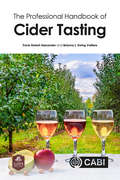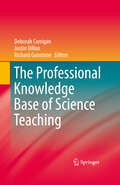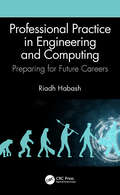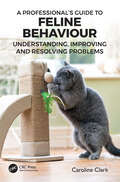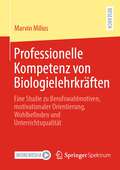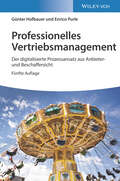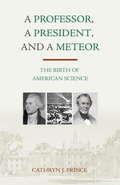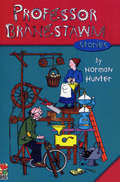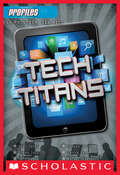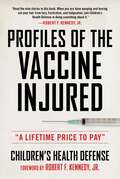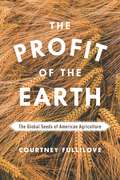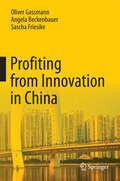- Table View
- List View
Production Technology of Stone Fruits
by Mohammad Maqbool Mir Umar Iqbal Shabir Ahmad MirGlobally stone fruits are emerging in the market due to the increased consumer’s desire for health-promoting foods. Stone fruits attract research attention, mainly due to the cultural and commercial aspects of the array of varieties that are grown. Being grown in wide range of environments, it is very important to understand what factors influence the production and quality attributes of stone fruits. There is a lack of systematic scientific information on strategic approach for production technologies of such fruits. This book will be first of its kind focusing on technological aspects of stone fruits especially on latest developments in present day horticulture. It will be an essential reference for professionals including academicians, scholars, researchers and industries working in the said area. We hope that readers will find this book a useful resource for their research or studies, and it will be helpful in the development of high quality stone fruits in future which will improve the economic and social life of people. Besides, this book fulfills the needs of a number of horticultural courses of Universities and will serving as a pomological manual for all occasions.
Production Technology of Underutilized Vegetable Crops
by Savita Monisha Rawat Vrince VimalThis volume discusses the nutraceutical importance, production technologies, management and cultivation practices of underutilized vegetables, which can be described as those vegetable crops which are neither grown commercially on a large scale nor traded widely. While much of the crops addressed in the book are cultivated, traded and consumed at the local level, there are over 60 species of minor vegetables with high growth and yield potentials that are not cultivated to a large extent for greater populations. This work highlights the production technologies needed to grow these vegetables on a larger scale and under various adverse soil and climatic conditions, and their nutritional and medical benefits to assist with food security, health and poverty alleviation in rural areas. Production of underutilized vegetables is low, due to the unavailability of planting material, lack of awareness about the nutritional and medicinal importance among the farmers and inadequate information on the production techniques of these crops. In this context, there is an urgent need to take up a program on genetic resources exploration, management, utilization, and improvement of underutilized vegetable crops to ensure food and nutritional security. Readers will learn about these technologies and practices, while also learning about the unique properties and benefits of these underutilized vegetables. The book will be useful for academicians and researchers focusing on vegetable production and breeding, as well as farmers and sustainability scientists looking for underexplored sources of nutrition to benefit large rural populations.
Production, Use, and Sustainability of Groundwater: Groundwater Economics, Volume 1
by Charles A. JobGroundwater is becoming increasingly scarce while the demand for water continues to grow at a global scale. Understanding groundwater resources and their sustainable management is imperative for the future of groundwater use, conservation and protection. This revised and updated two-volume set, focused on sustainability, covers the economic values of groundwater production and use, including micro- and macroeconomic factors, groundwater markets, economic evaluation tools, climate change, transboundary issues and policy evaluation. It explores numerous applications and describes ways to evaluate the economics of groundwater use in the context of the larger ecosystem and the natural capital it provides. FEATURES OF THIS VOLUME Includes an important new chapter on groundwater sustainability management Addresses new examples of groundwater use that are applicable at both the local and international levels Provides the foundation for policy, program and project analysis for all major uses of groundwater Updates groundwater use data along with explanations of major production costs and use benefits Gives a new perspective on users’ competition for the subsurface environment Production, Use, and Sustainability of Groundwater, Second Edition, the first volume of the two-volume set Groundwater Economics, is a must-have for any professional or student who needs to understand, evaluate and manage water resources from a range of production and use perspectives affecting groundwater resource sustainability.
Production Yield of Muon-Induced Neutrons in Lead
by Holger KluckThe work presented in this book is a major step towards understanding and eventually suppressing background in the direct search for dark matter particles scattering off germanium detectors. Although the flux of cosmic muons is reduced by many orders of magnitude in underground laboratories, the remaining energetic muons induce neutrons through various processes, neutrons that can potentially mimic a dark matter signal. This thesis describes the measurement of muon-induced neutrons over more than 3 years in the Modane underground laboratory. The data are complemented by a thorough modeling of the neutron signal using the GEANT4 simulation package, demonstrating the appropriateness of this tool to model these rare processes. As a result, a precise neutron production yield can be presented. Thus, future underground experiments will be able to reliably model the expected rate of muon-induced neutrons, making it possible to develop the necessary shielding concept to suppress this background component.
Productive Biofilms
by Kai Muffler Roland UlberThis book review series presents current trends in modern biotechnology. The aim is to cover all aspects of this interdisciplinary technology where knowledge, methods and expertise are required from chemistry, biochemistry, microbiology, genetics, chemical engineering and computer science. Volumes are organized topically and provide a comprehensive discussion of developments in the respective field over the past 3-5 years. The series also discusses new discoveries and applications. Special volumes are dedicated to selected topics which focus on new biotechnological products and new processes for their synthesis and purification. In general, special volumes are edited by well-known guest editors. The series editor and publisher will however always be pleased to receive suggestions and supplementary information. Manuscripts are accepted in English.
Productive Multivocality in the Analysis of Group Interactions
by Daniel D. Suthers Kristine Lund Carolyn Penstein Rosé Chris Teplovs Nancy LawThe key idea of the book is that scientific and practical advances can be obtained if researchers working in traditions that have been assumed to be mutually incompatible make a real effort to engage in dialogue with each other, comparing and contrasting their understandings of a given phenomenon and how these different understandings can either complement or mutually elaborate on each other. This key idea applies to many fields, particularly in the social and behavioral sciences, as well as education and computer science. The book shows how we have achieved this by presenting our study of collaborative learning during the course of a four-year project. Through a series of five workshops involving dozens of researchers, the 37 editors and authors involved in this project studied and reported on collaborative learning, technology enhanced learning, and cooperative work. The authors share an interest in understanding group interactions, but approach this topic from a variety of traditional disciplinary homes and theoretical and methodological traditions. This allows the book to be of use to researchers in many different fields and with many different goals and agendas.
Productive Safety Management: A Strategic, Multi-disciplinary Management System For Hazardous Industries That Ties Safety And Production Together
by Tania MolUnlike most books on this subject, Productive Safety Management, described in this book, integrates occupational health and safety, human resource management, environmental management, and engineering to provide a whole-business approach to effective safety management.The book helps companies to reduce and manage risk by providing, analysing and improving systems in place within the company. It also looks at how external factors can affect company decision making and provides a tool to make sure that a health and safety management system is strategically aligned, appropriately resourced, and that it maximises employee commitment. Chapters on human resource management explore cultural issues and explain how to gain commitment to company objectives.The book has been written for managers and supervisors working in hazardous industries, OHS practitioners, undergraduate and postgraduate students.
Productivity Effects of Cropland Erosion in the United States (Routledge Revivals)
by Pierre R. CrossonIn the 1970’s, agriculture in the United States seemed to be booming. With an extra demand for crops, extra acres were taken on to increase production which was predicted to increase further with an ever-growing population. However, concerns were beginning to be raised over the adequacy of land for crops as potential croplands began to be converted into urban areas as well as the effects of soil erosion decreasing the quality of these croplands. Originally published in 1983, this study investigates the threats to crop productivity in the U.S. with a focus on human-made problems. This title will be of interest to students of environmental studies.
Products of Random Variables: Applications to Problems of Physics and to Arithmetical Functions (Chapman & Hall/CRC Pure and Applied Mathematics)
by Janos Galambos Italo SimonelliProducts of Random Variables explores the theory of products of random variables through from distributions and limit theorems, to characterizations, to applications in physics, order statistics, and number theory. It uses entirely probabilistic arguments in actualizing the potential of the asymptotic theory of products of independent random variab
Produktionstechnische Praxis: Grundlagen chemischer Betriebstechnik
by Dieter Lischewski Bernhard Behle Annerose Hahn Wolfgang ReinWork in chemical production requires that technicians, workers and trainees are fully informed on all aspects of industrial processes. This book treats the fundamentals of chemical engineering and contains essential information about materials in piping systems. In addition, reaction techniques and requirements for environmental protection in the chemical industry are provided. This exceptional book is especially valuable for laboratory assistants, technicians and foremen in the chemical industry.
The Profession and Practice of Horticultural Therapy
by Rebecca L. Haller Karen L. Kennedy Christine L. CapraThe Profession and Practice of Horticultural Therapy is a comprehensive guide to the theories that horticultural therapists use as a foundation for their practice and provides wide-ranging illustrative models of programming. This book aims to enhance understanding and provide insight into the profession for both new and experienced practitioners. It is directed to students in the field, along with health care and human service professionals, to successfully develop and manage horticultural therapy programming. The book is organized into four sections: an overview of the horticultural therapy profession, theories supporting horticultural therapy use, models for programs, and tools for the therapist. Areas of focus include: Overview of the profession, including the knowledge, skills, and abilities needed to practice Discussion of related people-plant endeavors and theories supporting horticultural therapy Issues within the profession of horticultural therapy, including employment models, professionalism and ethics, and credentials Characteristics and implementation of therapeutic, vocational, and wellness program models Accommodations and adaptive techniques to best serve the needs of all participants Strategies for assessment and documentation for horticultural therapy intervention Issues for managing programs including how horticultural therapy programs collaborate with other disciplines, determining program costs and budget, managing staff and growing spaces, and conducting program evaluations Horticultural therapy serves the needs of the whole individual when practitioners have a broad and deep comprehension of the theories, techniques, and strategies for effective program development and management. The Profession and Practice of Horticultural Therapy provides relevant and current information on the field with the intent to inspire best practices and creative, effective programs.
Professional and Technical Writing Strategies: Communicating in Technology and Science (Fifth Edition)
by Merrill D. Tritt Judith S. VanalstyneThis book is designed to be used as a textbook by college and university students. However, its scope is, by design, much broader than that. It has applications for those writing in the fields of science, technology, business. It can be used by businesses to strengthen the writing abilities of those writing manuals. An excellent book with a wide range of applications. Good examples and practice exercises.
Professional Development in Science Teacher Education: Local Insight with Lessons for the Global Community (Reference Books in International Education)
by Pamela Fraser-AbderThis book explores global issues in the professional development of science teachers, and considers classroom applications of teacher training with a comparative lens. The twelve studies collected in this volume span five continents and vastly differing models of teacher education. Carefully detailing the social and cultural contexts for the teaching of science, this is a guidebook for anyone concerned with equity and reform in professional development.
The Professional Handbook of Cider Tasting
by Dr Travis Robert Alexander Dr Brianna Ewing ValliereIn recent years, with the rise of the craft beverage movement, the cider industry has been through a period of rapid commercial and non-commercial growth. Tasting and quality control is a core aspect of successful cider making and it is essential for industry and researchers to characterize cider using a standard, quantifiable metric. This book is a research-based text for understanding both the theory and practice of effectively evaluating the sensory properties of cider. The Professional Handbook of Cider Tasting includes content on the physiological basis of sensory evaluation, effective profiling of sensory evaluation, types and styles of cider, origins of cider quality attributes and direction for pairing cider with foods. The book also: - Covers a broad range of cider tasting techniques with associated technical explanations. - Provides data and research-driven information. - Contains sample sensory evaluation sheets, a tasting wheel, and guidance for creating fresh cider sensory standards and the utilization of various apple cultivars. Including a summary of the current global cider styles, this is an invaluable resource for commercial cidermakers, non-commercial cidermakers, students on cider production courses, researchers and other industry and stakeholder personnel.
The Professional Knowledge Base of Science Teaching
by Justin Dillon Richard Gunstone Deborah CorriganOver the past twenty years, much has been written about the knowledge bases thought necessary to teach science. Shulman has outlined seven knowledge domains needed for teaching, and others, such as Tamir, have proposed somewhat similar domains of knowledge, specifically for science teachers. Aspects of this knowledge have changed because of shifts in curriculum thinking, and the current trends in science education have seen a sharp increase in the significance of the knowledge bases. The development of a standards-based approach to the quality of science teaching has become common in the Western world, and phrases such as "evidence-based practice" have been tossed around in the attempt to "measure" such quality. The Professional Knowledge Base of Science Teaching explores the knowledge bases considered necessary for science teaching. It brings together a number of researchers who have worked with science teachers, and they address what constitutes evidence of high quality science teaching, on what basis such evidence can be judged, and how such evidence reflects the knowledge basis of the modern day professional science teacher. This is the second book produced from the Monash University- King's College London International Centre for the Study of Science and Mathematics Curriculum. The first book presented a big picture of what science education might be like if values once again become central while this book explores what classroom practices may look like based on such a big picture.
Professional Practice in Engineering and Computing: Preparing for Future Careers
by Riadh HabashThis book has been developed with an intellectual framework to focus on the challenges and specific qualities applicable to graduates on the threshold of their careers. Young professionals have to establish their competence in complying with multifaceted sets of ethical, environmental, social, and technological parameters. This competence has a vital impact on the curricula of higher education programs, because professional bodies today rely on accredited degrees as the main route for membership. Consequently, this four-part book makes a suitable resource for a two-semester undergraduate course in professional practice and career development in universities and colleges. With its comprehensive coverage of a large variety of topics, each part of the book can be used as a reference for other related courses where sustainability, leadership, systems thinking and professional practice are evident and increasingly visible. Features Identifies the values that are unique to the engineering and computing professions, and promotes a general understanding of what it means to be a member of a profession Explains how ethical and legal considerations play a role in engineering practice Discusses the importance of professional communication and reflective practice to a range of audiences Presents the practices of leadership, innovation, entrepreneurship, safety and sustainability in engineering design Analyzes and discusses the contemporary practices of project management, artificial intelligence, and professional career development.
A Professional’s Guide to Feline Behaviour: Understanding, Improving and Resolving Problems
by Caroline ClarkA Professional's Guide to Feline Behaviour is an invaluable resource for the feline professional, yet written in such an accessible way that it would be of interest to anyone who shares their life with a cat and wants to gain a deeper understanding of their behaviour.The book is presented in easy-to-navigate sections, each packed with practical advice and the colour illustrations, tables and graphics throughout make it approachable for every type of reader.What this guide offers: A greater understanding of cats and how to meet their needs. How to recognise and mitigate negative emotions and deal with challenges that cats face both at home and particularly in the workplace. How to analyse feline behaviour accurately, with a view to designing a tailored behaviour modification plan. Comprehensive information on common, and not so common, problematic feline behaviours. The fundamentals of learning theory, with step-by-step training guides. Real-life case studies, accompanied by behaviour plans that integrate clinically proven methods to help manage or resolve a range of behaviour issues. Written by Caroline Clark, a Registered Clinical Animal Behaviourist and RCVS listed veterinary nurse, this well-researched book draws from her knowledge and professional experiences, offering a unique insight into feline behaviour.
Professionelle Kompetenz von Biologielehrkräften: Eine Studie zu Berufswahlmotiven, motivationaler Orientierung, Wohlbefinden und Unterrichtsqualität
by Marvin MiliusProfessionelle Handlungskompetenzen von Lehrkräften gelten als wichtige Voraussetzung für erfolgreichen Unterricht und das eigene Wohlbefinden im schulischen Arbeitskontext. In diesem Zusammenhang spielt vor allem die motivationale Orientierung, als ein Teilaspekt der Lehrkräftekompetenz, eine signifikante Rolle dabei, inwiefern bestimmte Verhaltensweisen und Anstrengungen beim Unterrichten zum Tragen kommen. Vor diesem Hintergrund stellt sich die Frage, welchen Einfluss motivationale Faktoren auf die Unterrichtsqualität und das arbeitsbezogene Wohlbefinden bei Biologielehrkräften haben. Die Analysen zeigen, dass neben den Selbstwirksamkeitserwartungen insbesondere der Lehrerenthusiasmus eine besondere Bedeutung für die Unterrichtsqualität und das arbeitsbezogene Wohlbefinden der Biologielehrkräfte hat. Zusammenfassend bekräftigen die Ergebnisse die Wichtigkeit motivationaler Kompetenzen und implizieren eine stärkere Förderung dieser in den Phasen der Lehrerbildung.
Professionelles Vertriebsmanagement: Der digitalisierte Prozessansatz aus Anbieter- und Beschaffersicht
by Günter Hofbauer Enrico PurleProfessionelles Vertriebsmanagement Das Standardwerk zum Vertriebsmanagement in neuer Auflage: aktualisiert, gestrafft und ergänzt mit dem Thema Digitalisierung im Vertrieb. Dem Vertriebsmanagement kommt in der markt- und werteorientierten Unternehmensführung eine Schlüsselrolle für den Erfolg zu, denn die Unternehmen leben vom Verkauf ihrer Produkte und Dienstleistungen. Dafür ist ein profundes Verständnis der Vorgänge im Markt und bei den Kundinnen und Kunden erforderlich. Das Konzept des Customer Relationship Managements (CRM) bietet dafür die inhaltliche Basis, dessen kompetente Umsetzung im Vertriebsmanagement ist der wesentliche Erfolgsfaktor zur Erschließung der Markt- und Kundenpotenziale. Das Buch hilft Fach- und Führungskräften in Unternehmen, ihre Kompetenzen im Vertriebsmanagement zu erweitern, und Studierenden, entsprechende Kenntnisse zu erwerben. Im Vordergrund steht die zielorientierte Prozessorganisation des Vertriebsmanagements als Schlüssel zum Erfolg. Die Autoren nutzen dazu das von ihnen entwickelte Referenzmodell aus Selling Cycle und Buying Cycle und berücksichtigen damit sowohl die Anbietersicht als auch die Kundensicht. Für die vorliegende fünfte Auflage haben sie vor allem neue Aspekte der Digitalisierung entlang des gesamten Vertriebsprozesses integriert.
A Professor, A President, and A Meteor
by Cathryn J. PrinceWhen a fiery meteor crash in 1807 lit up the dark early-morning sky in Weston, Connecticut, it did more than startle the few farmers in the sleepy village. More importantly, it sparked the curiosity of Benjamin Silliman, a young chemistry professor at nearby Yale College. His rigorous investigation of the incident started a chain of events that eventually brought the once-low standing of American science to sudden international prominence. And, by coincidence, the event also embroiled Silliman in politics, pitting him against no less an adversary than President Thomas Jefferson. Based on a wealth of original source documents and interiews with current experts in history, astronomy, and geology, this journalist tells the remarkable story of Benjamin Silliman, arguably America's first bonafide scientist. In a lively narrative rich with fascinating historical detail, the author documents the primitive state of American science at the time; Silliman's careful analysis of the meteor samples; and the publication of his conclusions, which contradicted both popular superstitions regarding meteors as ominous portents and a common belief that meteors come from volcanic eruptions on the moon. She also describes Silliman's struggles to build a chemistry department at Yale with rudimentary material; new insights into geology that resulted from his analysis of the meteor; and his report to the prestigious French Academy, which raised the prestige of American science. Finally, she discusses the political turbulence of the time, which Silliman could not escape, and how the meteor event was used to drive a wedge between New England and Jefferson. This is a fascinating vignette of Federal Period America when science on this continent was still in its infancy, but was just beginning to make its mark.
Professor Branestawm Stories
by Norman HunterHe's madly sane and cleverly dotty. Professor Branestawm is the craziest genius you'll ever meet and he's back with this bumper collection of hilarious adventures, zany inventions and mind-boggling experiments. So open up for a wacky collection of stories, riddles, puzzles, tricks and tips . . . You'll never get the better of Professor Branestawn but now you can at least get the best!
Profiles #3: Tech Titans (Profiles #3)
by Carla Killough McclaffertyFull-color series-six bios in one! It takes more than one person to bring about change and innovation. Explore the lives of the people who have had a huge impact on technology today. So much more than just your typical biography, PROFILES: TECH TITANS focuses on six of the most prominent figures in the technological world. This book includes all of the biographical information kids need to know (background, family, education, accomplishments, etc.) about Bill Gates, Steve Jobs, Mark Zuckerberg, Larry Page, Sergey Brin, and Jeff Bezos--the men behind Windows, Apple, Facebook, Google, and Amazon! Photographs and quotes will be interwoven throughout the text.
Profiles of the Vaccine-Injured: "A Lifetime Price to Pay" (Children’s Health Defense)
by Children's Health Defense Robert F. Kennedy Jr.Are vaccine injuries really &“one in a million,&” as governments and public health experts constantly tell us? This comprehensive look at the evidence by Children&’s Health Defense, illustrated by nine real-life stories of serious vaccine injury, exposes health agencies&’ soft-pedaling of vaccine risks as a dangerous lie. For most people, the potential risks of vaccination, which include life-changing illness, family bankruptcy, and even death, are invisible and almost inconceivable—until a vaccine injury happens to them. Through the poignant and riveting stories of nine injured children and adults, Profiles of the Vaccine-Injured by Children&’s Health Defense communicates the devastating impacts of vaccine damage on health, family finances, relationships, and more. As the book&’s introductory chapters show, vaccine injuries—whether from a routine childhood injection—or a travel vaccine—or a COVID-19 shot—are common, not rare. Discussing US children&’s poor showing in global health rankings, the book assembles compelling evidence pointing to childhood vaccination as a key &“elephant in the room.&” The heart of the book resides in the vaccine injury stories told by mothers of injured children and injured adults. Conveying in vivid detail what it&’s like to live with conditions such as severe autism, chronic pain, and immune systems gone haywire, the nine individuals also attest to the disturbing fact that &“when it comes to vaccine injuries, there&’s no help legally or financially—you&’re on your own.&” In addition, they share affecting accounts of gaslighting, a lack of answers or solutions and outright hostility from the medical community, social isolation, heavy financial burdens, and interrupted careers and lives. Exposing the truth behind the vaccine safety myth, Profiles of the Vaccine-Injured makes vaccine injury personal and demonstrates that we ignore vaccine risks at our peril.
The Profit of the Earth: The Global Seeds of American Agriculture
by Courtney FulliloveWhile there is enormous public interest in biodiversity, food sourcing, and sustainable agriculture, romantic attachments to heirloom seeds and family farms have provoked misleading fantasies of an unrecoverable agrarian past. The reality, as Courtney Fullilove shows, is that seeds are inherently political objects transformed by the ways they are gathered, preserved, distributed, regenerated, and improved. In The Profit of the Earth, Fullilove unearths the history of American agricultural development and of seeds as tools and talismans put in its service. Organized into three thematic parts, The Profit of the Earth is a narrative history of the collection, circulation, and preservation of seeds. Fullilove begins with the political economy of agricultural improvement, recovering the efforts of the US Patent Office and the nascent US Department of Agriculture to import seeds and cuttings for free distribution to American farmers. She then turns to immigrant agricultural knowledge, exploring how public and private institutions attempting to boost midwestern wheat yields drew on the resources of willing and unwilling settlers. Last, she explores the impact of these cereal monocultures on biocultural diversity, chronicling a fin-de-siècle Ohio pharmacist’s attempt to source Purple Coneflower from the diminishing prairie. Through these captivating narratives of improvisation, appropriation, and loss, Fullilove explores contradictions between ideologies of property rights and common use that persist in national and international development—ultimately challenging readers to rethink fantasies of global agriculture’s past and future.
Profiting from Innovation in China
by Sascha Friesike Angela Beckenbauer Oliver GassmannChina is dramatically catching up and is rapidly becoming a leading technological innovator on the global scale. The number of Chinese firms with global ambitions is growing fast, more and more technological innovation is coming from China, and the number of patents in China is also growing steadily. The negative side of this development is the still insufficient protection of intellectual property in China. The phenomenon of counterfeits originating from China has increased constantly over the past two decades. Moreover, within the past ten years the scale of intellectual property theft has risen exponentially in terms of its sophistication, volume, the range of goods, and the countries affected. This book addresses managers dealing with innovation in China, and offers concrete advice on how Western firms can benefit from these innovations. Among others, it provides examples and checklists to help decision-makers active in China.
